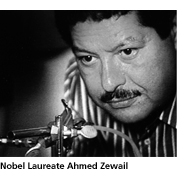
Less Than the Blink of an Eye
 SAS
alumnus Dr. Ahmed Zewail, G’74, Hon’97, the Linus Pauling Professor
of Chemical Physics at Caltech, was awarded the 1999 Nobel Prize in chemistry
for his pioneering work in femtochemistry. Ed Wasserman, president of the American
Chemical Society, called him "the father of femtochemistry," the chemistry
that transpires over time scales that are measured in extremely small fractions
of a second. Zewail is the second SAS alumnus to win a Nobel in three years;
Dr. Stanley Prusiner, C’64, M’68, another chemistry department graduate,
received the prize in 1997 for his discovery of the prion."Professor Zewail’s
contributions have brought about a revolution in chemistry and adjacent sciences,"
said the Royal Swedish Academy. He was awarded the Nobel for advancing understanding
of the way chemical bonds form and break by "showing that it is possible
with rapid laser technique to see how atoms in a molecule move during a chemical
reaction."
SAS
alumnus Dr. Ahmed Zewail, G’74, Hon’97, the Linus Pauling Professor
of Chemical Physics at Caltech, was awarded the 1999 Nobel Prize in chemistry
for his pioneering work in femtochemistry. Ed Wasserman, president of the American
Chemical Society, called him "the father of femtochemistry," the chemistry
that transpires over time scales that are measured in extremely small fractions
of a second. Zewail is the second SAS alumnus to win a Nobel in three years;
Dr. Stanley Prusiner, C’64, M’68, another chemistry department graduate,
received the prize in 1997 for his discovery of the prion."Professor Zewail’s
contributions have brought about a revolution in chemistry and adjacent sciences,"
said the Royal Swedish Academy. He was awarded the Nobel for advancing understanding
of the way chemical bonds form and break by "showing that it is possible
with rapid laser technique to see how atoms in a molecule move during a chemical
reaction."
The technique is an ultra-quick laser spectroscopy, a fast-pulsed laser that allows researchers to take pictures of chemical reactions in real time. The technology, which some have called the world’s fastest camera, allows scientists to directly observe and record individual micro-events such as how light changes a plant-pigment molecule as part of photosynthesis. It’s a chemistry measured in femtoseconds (0.000000000000001 of a second), which is the same fraction of a second as is the proportion of one second to 32 million years. "People were working with lasers and with very short laser pulses, but what he did was to . . . measure directly how atoms moved during chemical reactions," said chemistry professor Robin Hochstrasser, who worked with Zewail as a graduate student.
Dr. Zewail was born and raised in Egypt. He came to the U.S. to study at Penn and now holds dual citizenship. In 1998, Egypt issued two postage stamps with his likeness as a tribute to his scientific achievements.